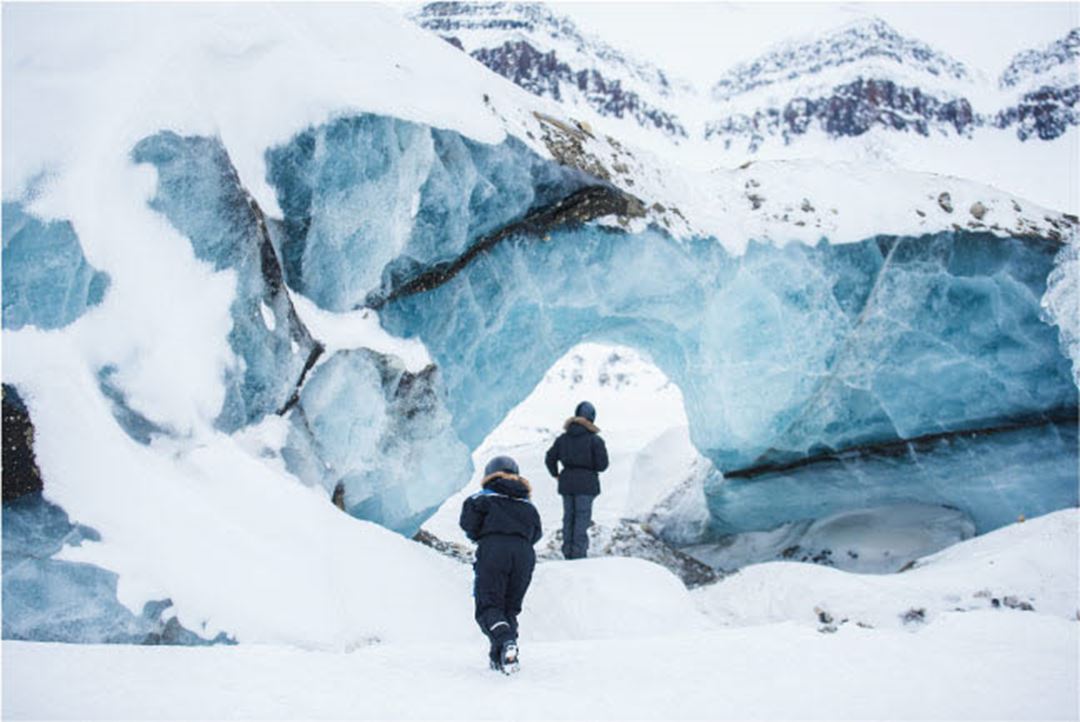Authors: Mark Mulrooney, Postdoc NCCS and Peter Betlem, PhD NCCS
NCCS researchers are now studying Svalbard's subsurface and outcrops to gain important integrity data that will help to successfully deliver carbon capture, transport and storage (CCS), a critical climate change mitigation technology. For instance, data for rock physics models are needed to help us better detect and predict the behaviour of fluid flow following any potential breach.
The research attracted interest from far and wide, and not just from scientists. A large male polar bear paid two visits to the field researchers at Deltaneset, causing some disruption to the schedule. However, the scratches and scrapes on the old UNIS cabin used as the research base reminded everyone of their status as guests.
Why Svalbard?
Subsurface saline aquifers in the Norwegian sector of the North Sea that have been earmarked for injection and storage of CO2 date back many millions of years to two phases of continental rifting. These rift events lead to the development of sedimentary basins which now offer porous and permeable storage formations for potential CO2 storage. Assessing the caprock integrity is difficult given limited subsurface data, but is much more feasible at the geologically-similar succession in Svalbard.
This succession had previously been investigated as a caprock by the University Centre in Svalbard's (UNIS) CO2 lab. This gave NCCS researchers a wealth of multi-scale, multi-disciplinary data to build on.
Field work to fill knowledge gaps
Researchers from across Norway came together on Svalbard last year to conduct important caprock integrity analysis. The research, part of NCCS task 9, aims to fill knowledge gaps about how subsurface faults and fractures will influence CO2 migration and containment.
Thanks to the NCCS mobility fund, the University of Oslo's Mark Mulrooney spent four weeks in Svalbard in collaboration with UNIS' Dr Kim Senger. "I participated in a field campaign followed by computer lab work aimed at synthesizing outcrop observations with the pre-existing Svalbard geomodel established over the past decade by the UNIS CO2 lab. The fundament of the research is to assess the reactivation potential of heterogeneities intersecting the caprock and as such determine caprock integrity," says Mark.
Thousands of measurements from faults and fractures
During a two-week field campaign, thousands of orientation measurements from faults and fractures were taken as well as information on aperture, mineral infill, vertical extent and frequency.
Work will continue, but key initial findings include the presence of low angle normal faults in the lower part of the Agardhfjellet Formation, and low angle reverse faults in the upper part. Higher fracture frequency up section is also apparent. These structures are too small to image with conventional seismic surveys but can significantly influence fluid flow. As such it is important to investigate these structures in the field.
Digitising the larger structures that intersect the Agardhfjellet Formation and compiling subsurface parameters derived from the UNIS CO2 lab (e.g. in situ stresses and pore pressure) reactivation potential could be calculated. "The caprock integrity analysis results show subsurface faults are not prone to reactivation. The variable topography of Svalbard has some effect on the in-situ stress magnitudes at depth, however, it never compromises fault integrity," explains Mark. Future work hopes to analyse how the caprock will respond on the scale of individual fractures.
Rock physics models help us understand the unknown
Peter Betlem is a PhD candidate in Arctic Geology at UNIS and the University of Oslo. He uses much of the data gleaned from Svalbard to assess the multi-physical detection limit of fluid flow through caprock sequences.
"Rock physics models provide a link between known rock properties and the unknown, resulting properties picked up during seismic and electromagnetic exploration. The more data we acquire on a sample, an interval, or even a formation, the better we can correlate these different properties to one-another. In turn, this allows us to better predict properties for unsampled intervals, provided at least some of the properties are known in the first place," explains Peter.
A digital success story on Svalbard
Eight fully cored boreholes supplemented by wireline logging provided many key properties for characterisation, but additional work was needed to fill knowledge gaps. The qualitative density wi- reline logging was one such gap. Rather than use the established method that risked destroying the samples, Peter and his colleagues experimented with structure-from-motion (SfM) photogrammetry.
Much like how our own eyes work, photogrammetry allows for the estimation of 3D structures from 2D image sequences. Ground control points (GCPs) add real world coordinates to the synthesised 3D models and allow for sub-millimetre resolutions in the process. After several weeks of finetuning the workflow, digital drill core models were acquired with sub-millimetre spatial errors. Subsequent analysis from the Norwegian Geotechnical Institute in Oslo showed that the bulk volumes and densities derived digitally closely matched the geotechnical measurements.
Following this success, the team is now expanding this digitisation effort to cover the entire cored caprock sequence of the Longyearbyen CO2 Lab by digitising drill cores at 1 metre intervals. "Not only does this provide us with the data needed to quantify the density logs, it also enables the establishment of the very first digital drill core library. All acquired digital drill core models will eventually be integrated with Svalbox.no, an initiative established to provide an interactive frontend to all geoscientific data originating from Svalbard," says Peter.
CO2 research on Svalbard
Research into CO2 and Carbon Capture, Transport and Storage (CCS) technology has been carried out by the University Centre in Svalbard (UNIS) since 2007. In early 2012, the UNIS CO2 Lab was founded as a spin-off company, fully owned by UNIS. The lab aims to take advantage of Longyearbyen's closed energy system, which is powered by Norway's only coal-fuelled power plant that also delivers heat to the town's buildings.
The small community could demonstrate the full CCS value chain becoming a global showcase for how to take care of CO2 from source to solution. Such knowledge and competence acquired in Longyearbyen can be utilised on global projects. The studies of sub-surface structures will benefit storage projects elsewhere, including the research taking place within NCCS.
This article was first presented in the NCCS Annual Report 2019.


